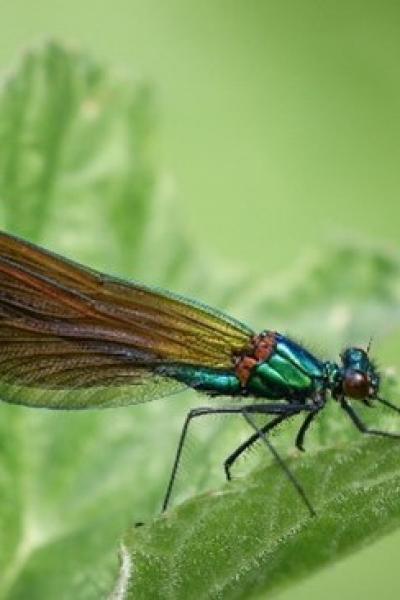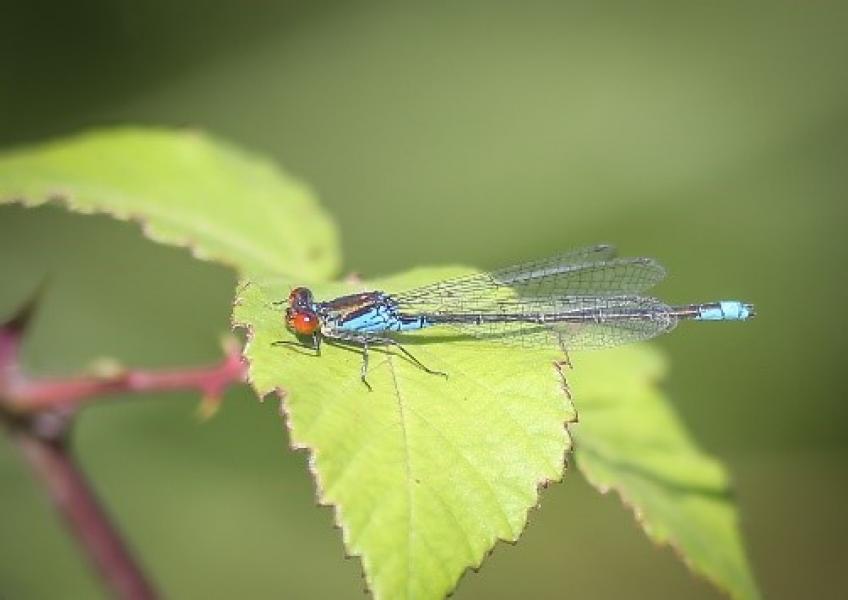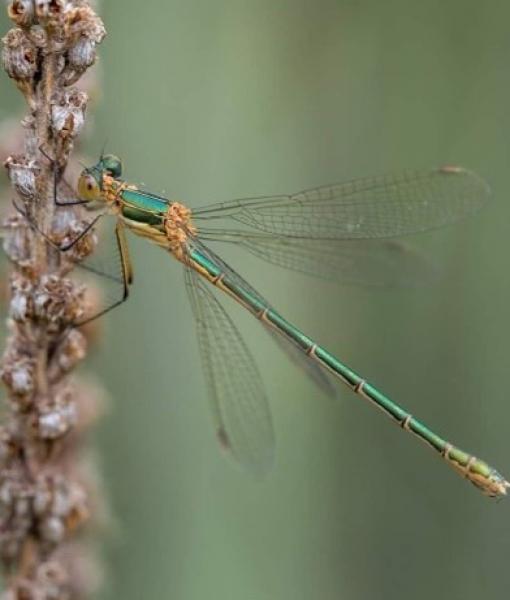Azure Damselfly males are pale blue whereas females are usually greener but can be blue. They can often be confused with the Common Blue Damselfly. Azures have thinner blue lines on their thorax and a small H shaped marking on the first abdominal segment just below the wing bases – similar to a Honda logo H. First emergences are in early May with sightings possible into early September. They live in slow flowing and still waters

Banded Demoiselles are slightly larger than the usual damselflies. Males are a dark blue or green, with a dark ‘thumbprint’ on the wings. Females are a paler green with translucent green wings. Females can become brassier in colour as they mature. They are one of the first species to emerge along the river in late April/early May and can be found into early September. They favour slower moving waters and are quite prolific along the Rivers Avon and Arrow.

Very similar to the Banded Demoiselle, the Beautiful Demoiselle can be identified by their wings. Males have fully dark wings and the females have copper coloured wings, with white markings slightly further from the wing tips than their Banded cousins. Beautiful Demoiselles prefer fast moving water, normally found in smaller streams, they emerge a little later than the Banded and are difficult to find after mid-August.

The Blue Tailed Damselfly is a small damselfly with a slender dark body with a blue tail. Females can vary in colour, with blue, green orange and violet forms being present. The wing spots are diamonds of half grey and half black. Common in still and flowing waters from May through to September.

Very similar to the Azure Damselfly, the male Common Blue has a bluer body, with thicker blue lines on the thorax, behind the head. Females are again greenish and easily confused with Azure. Present at still and flowing water from May through to early September.
Often the first species found each season, the Large Red Damselfly is another smaller Damselfly with mostly red colouration. Legs are black, eyes will change from yellow/orange through to red as individuals mature. Males are thinner in body than females and only have markings near the end of the tail, whereas females have clear markings all along their thicker bodies. Not to be confused with the slighter-bodied Small Red Damselfly which is identified by its red legs, and has not been recorded in Warwickshire. Large Reds are found at still and flowing waters, though have proved uncommon along the river in recent years.

The Red Eyed Damselfly found at still and flowing waters, is another blue male/greenish female damselfly. The male shows clear red eyes and no striped on the thorax. Females are greener with more brown than red eyes. Often found resting on lily pads near the banks of the river, mid-May to August

A species of some concern at a National level, the White Legged Damselfly is locally common along the River Avon. Emerging mid-May, males start as white/cream coloured but soon mature to a pale blue – easily confused with Azures and Common Blues… A close look will show there to be double thin lines on the back of the thorax, rather than the thicker single lines of the other species. Females are a creamy-beige colour. Both have arrow shaped marking along the thorax and brown wing spots.

Emerging later in the year than its larger cousin, the Small Red Eyed Damselfly can be found around ponds from mid-July on to September, usually flitting about on surface weeds

The Emerald Damselfly can be found mainly near still waters from late May onwards, sometimes as late as early October. The Emerald is green and brown when freshly emerged, though the brown areas become pruinecent in the males when mature and the eyes become bright blue. Emeralds often rest with their wings spread; a notable difference to most other damselflies.

Photo credits to Mike Schilling.



